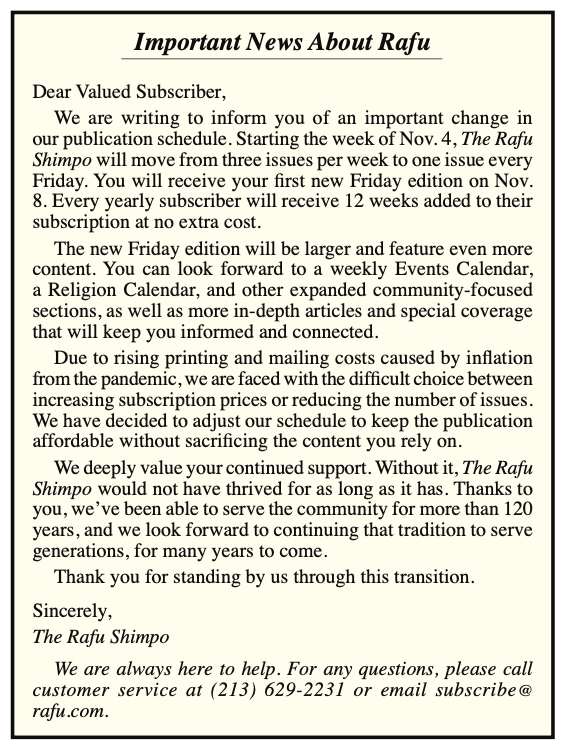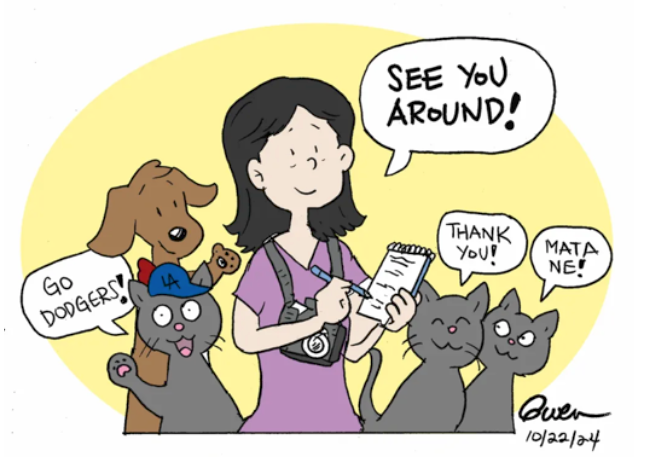121-year-old newspaper’s Muranaka, Miyasaki both resign on Nov. 1.
By P.C. Staff
In what may be the latest signal of its imminent demise, the Rafu Shimpo — the 121-year-old L.A.-based bilingual Japanese American community newspaper — announced it was going to a once-a-week schedule from three-days a week, citing increased costs, with its first weekly issue to be published Nov. 8.
The notice stated that the “new Friday edition will be larger and feature even more content” and that existing yearly subscribers would receive an additional 12 weeks more to their subscriptions — currently $50 annually for digital-only and $180 annually for a print and digital — “at no extra cost.”

Front page article from the Oct. 31, 2024 Rafu Shimpo
The cutback in frequency of publication and the resignations are the latest signs of long-running woes at the Rafu Shimpo — and challenges facing all newspapers since the rise of the internet.
In news that was not reported in the Rafu Shimpo announcement, the Pacific Citizen confirmed that the Rafu Shimpo’s senior editor, Gwen Muranaka, and its longtime office manager and English-language advertising lead, Gail Miyasaki, both resigned on Nov. 1.
Miyasaki is a daughter of Akira Komai, the newspaper’s second-generation owner-publisher who died in 1983 at age 75 and the sister of the newspaper’s publisher and president, Michael Komai, 72, who took over as the family’s third-generation publisher after their father’s death.
Muranaka was with the Rafu Shimpo for 24 years, most recently as its senior editor for both the English and Japanese language sections, and was recently recognized at the Aug. 14 Nisei Week Foundation’s Pioneer Spirit Award luncheon with a Pioneer Spirit award. (see Pacific Citizen, Sept. 6, 2024). In late 2023, the Society of Professional Journalists also presented her with its Distinguished Journalist Award. Prior to working at the Rafu Shimpo, Muranaka worked at Pacific Citizen in the 1990s as an assistant editor.
In a conversation with the Pacific Citizen after her departure, Muranaka said her decision to leave was unrelated to the Rafu Shimpo’s decision to go weekly, a development she called “very concerning.”
As for why she resigned, Muranaka said, “When you are in any place for that long, there’s going to be a variety of reasons.” In her farewell column, she wrote: “It hasn’t been an easy decision, but it’s the right one.”

Gwen Muranaka illusrated this cartoon that accompanied her farewell column
She added that she still had a few postdeparture writing assignments to complete and since her announcement had received communications from many people expressing their thanks to her years of work.
Newspapers serving ethnic communities have not been immune to woes afflicting the print journalism business. In 2009, San Francisco’s two for-profit Japanese American newspapers — the Hokubei Mainichi and the Nichi Bei Times — both went out of business. Staffers from Nichi Bei Times subsequently formed the nonprofit Nichi Bei News, which is still extant.
In 2023, the Associated Press’ David Bauder, citing a 2023 report by Northwestern’s Medill journalism school, related that “the nation has lost one-third of its newspapers and two-thirds of its newspaper journalists since 2005” and an “average of 2.5 newspapers closed each week in 2023 compared to two a week the previous year, a reflection of an ever-worsening advertising climate.”
Regarding the challenges facing the Rafu Shimpo, they are nothing new. In 2010, word that the newspaper might have to shutter sparked a grassroots “Save the Rafu” campaign that included a meeting at the Gardena Valley Japanese Cultural Institute. That effort helped stave off its demise in the short run.
In March 2016, however, an open letter from the newspaper’s publisher stated: “Today we are at a crisis point. For the last three years, The Rafu has been losing money at an alarming rate: $750,000 over three years, with a projected deficit of $350,000 this year. The losses have been covered by the Komai family trust, but that remedy is unsustainable in the long run.
“If the situation does not improve this year, The Rafu will be forced to close in December of this year.”
A reassessment of its financial situation and a drive to grow the base of the digital version of the newspaper’s subscribers at the time managed to keep it going, although the Covid-19 pandemic a few years later created new challenges, including remote work that resulted in the frequency of publication dropping to three issues per week. In the 1980s, the Rafu Shimpo was published six days a week.



